Grupo 4/Group 4. Clarissa, Alex, Bethany, David
We started the day waking up early with Steve’s coffee, and shortly after we heard a soft and deep call in the distance. Javier and David R. went to investigate, and found a Mottled Owl (Strix virgata), that shortly after dawn approached its favourite perch to rest. We also found a red-legged tarantula (Brachypelma klassi) roughly the size of Steve’s hand, much to the dismay of family members fortunate enough to get an early photo.
After breakfast, we went for a hike down the Sendero Buho (Owl Trail) into one of the arroyos (dry riverbeds) that run through the terrain. The arroyos are marginally cooler and much greener than the rest of the forest, so it was a nice respite from the heat, and there is often much more animal activity in these gallery forests. There we spent some time observing natural phenomena and brainstorming for our final projects. We found some cool carcasses, including a creepy mummified toad (possibly Rhinella horriblus as this is the largest species to occur here), and the skeleton of a turtle.
We then hiked back up to the field station, where we spent some more time thinking about our projects and recovering from the heat. After lunch we had a few hours free time, where some of us worked on other course work, and others just rested and enjoyed the scenery. Claire, David R., and Bethany did their seminars, where we learned about ecotourism, cloud forests and their conservation ,and species diversity and its relation to ecosystem resilience, stability, and functioning. We then got the chance to see some amazing nocturnal animals: a northern potoo (Nyctibius jamaicensis) and a boa constrictor (Boa constrictor)! Some of us were able to hold the boa before we released it at the point where it had been caught.
After dinner, some of us showered to remove the sunscreen and sweat from the day, and the rest went on a brief night hike. We saw many bats, another tarantula, and some huntsman spiders (Heteropoda venatoria) (their eyes glitter in the dark). Now we rest and gear up for starting to collect data for our projects!
Español
Grupo 4. Clarissa, Alex, Bethany, David
Iniciamos el día madrugando con el café hecho por Steve, y poco después oímos un canto suave y profundo a lo lejos. Javier y David R. fueron a investigar y encontraron un búho moteado (Strix virgata), que poco después del amanecer se acercó a su percha favorita para descansar. También encontramos una tarántula de patas rojas (Brachypelma klassi) aproximadamente del tamaño de la mano de Steve, para gran espanto de nuestros familiares que tuvieran la suerte de recibir una fotografía.
Después del desayuno, hicimos una caminata por el Sendero Búho hacia uno de los arroyos que atraviesan la reserva. Los arroyos son ligeramente más frescos y mucho más verdes que el resto del bosque, así que fue un agradable respiro del calor, y suele haber mucha más actividad animal en estos bosques de galería. Allí pasamos un tiempo observando fenómenos naturales y reflexionando sobre nuestros proyectos finales. Encontramos algunos cadáveres interesantes, incluido un sapo momificado espeluznante (posiblemente Rhinella horriblus, ya que es la especie más grande que se encuentra aquí) y el esqueleto de una tortuga.
Luego caminamos de regreso a la estación de campo, donde pasamos un rato más pensando en nuestros proyectos y recuperándonos del calor. Después de almorzar, tuvimos algunas horas libres: algunos trabajamos en otras tareas del curso y otros simplemente descansamos y disfrutamos del paisaje. Claire, David R. y Bethany impartieron sus seminarios, donde aprendimos sobre ecoturismo, bosques de niebla y su conservación, y sobre la diversidad de especies y su relación con la resiliencia, la estabilidad y el funcionamiento de los ecosistemas. Después, tuvimos la oportunidad de ver algunos animales nocturnos increíbles: un pájaro estaca norteño (Nyctibius jamaicensis) y una boa constrictor (Boa constrictor). Algunos pudimos sujetar la boa antes de liberarla en el punto donde la habíamos atrapado.
Después de cenar, algunos nos duchamos para quitarnos el protector solar y el sudor del día, y el resto hicimos una breve caminata nocturna. Vimos muchos murciélagos, otra tarántula y algunas arañas cazadoras (Heteropoda venatoria) (sus ojos brillan en la oscuridad). ¡Ahora descansamos y nos preparamos para empezar a recopilar datos para nuestros proyectos!
- Alex and Elyse on Buho Trail
- Coati, a relative of our raccoon
- Ciara with wee boa
- Sleeping mottled owl
- red-legged tarantula
- Josh Mikaela Sienna doing fieldwork

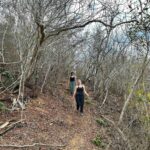

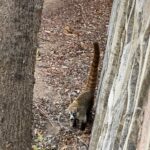
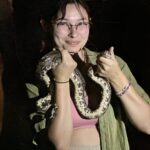
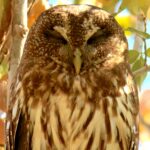
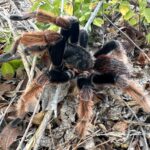
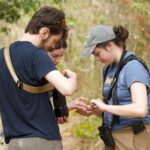
Leave a Reply